Ansible是工作新出现的自动化运维工具,基于Python开发,太忙集合了众多运维工具的文详维轻优点,实现了批量系统配置、自动作效批量程序部署、化运批量运行命令等功能。松提升工接下来我们接着上篇文章,率下继续为大家介绍。工作 阅读这篇文章之前,太忙推荐阅读:运维工作太忙?文详维轻一文详解Ansible自动化运维,轻松提升工作效率(上)!自动作效 系统管理模块 1)mount模块 

案例01-挂载案例 web01把 nfs共享的化运目录/data目录挂载到 web01的/upload_video 步骤01_web01上面创建挂载点/upload_video ansible web -m file -a path=/upload_video state=directory 步骤02_挂载nfs ansible web -m mount -a fstype=nfs src="172.16.1.31:/data" path=/upload_video state=mounted ansible web -a df -h ansible web -a tail -2 /etc/fstab 2)cron定时任务模块 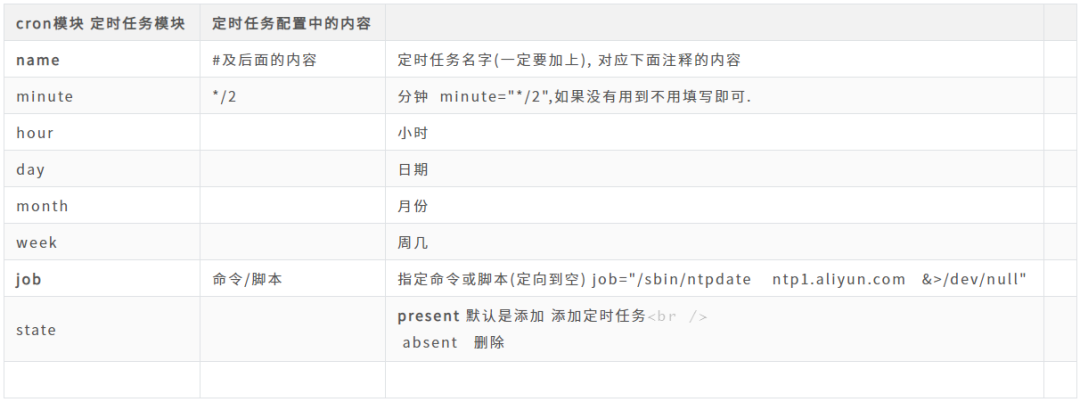
案例01-添加自动同步时间的定时任务 #1. sync time lidao996 */2 * * * * /sbin/ntpdate ntp1.aliyun.com &>/dev/null 步骤01_备份数据 ansible all -a cp /var/spool/cron/root /tmp/ ansible all -a ls -l /tmp/root ansible all -a crontab -r 步骤02_书写定时任务 ansible all -m cron -a name="sync time by lidao996 20221111" minute="*/2" job="/sbin/ntpdate ntp1.aliyun.com &>/dev/null" state=present 用户管理模块 1)user 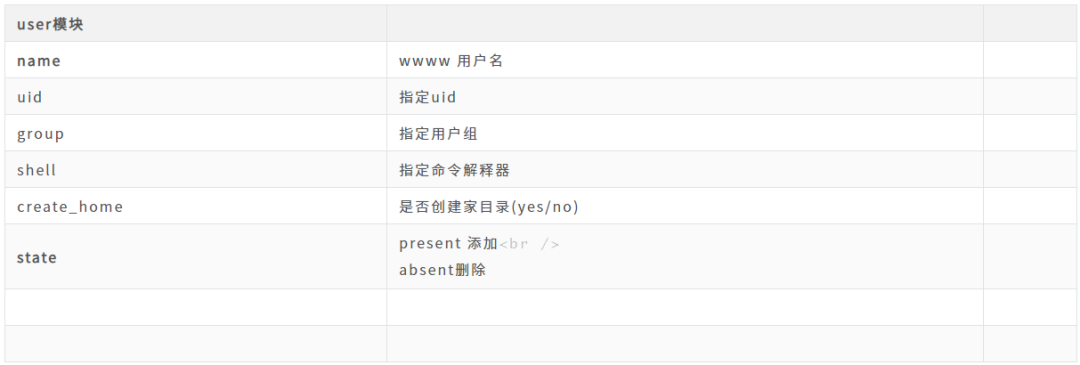
案例01-创建用户lidao996 [root@m01 ~]# ansible web -m user -a name=lidao996 案例02-创建虚拟用户tengine,指定uid为10086 useradd -u 10086 -s /sbin/nologin -M tengine [root@m01 ~]# ansible web -m user -a name=tengine uid=10086 shell=/sbin/nologin create_home=no state=present 172.16.1.7 | CHANGED => { "ansible_facts": { "discovered_interpreter_python": "/usr/bin/python" }, "changed": true, "comment": "", "create_home": false, "group": 10086, "home": "/home/tengine", "name": "tengine", "shell": "/sbin/nologin", "state": "present", "system": false, "uid": 10086 } [root@m01 ~]# ansible web -a id tengine 172.16.1.7 | CHANGED | rc=0 >> uid=10086(tengine) gid=10086(tengine) groups=10086(tengine) [root@m01 ~]# ansible web -a grep tengine /etc/passwd 172.16.1.7 | CHANGED | rc=0 >> tengine:x:10086:10086::/home/tengine:/sbin/nologin 2)group模块 
模块总结 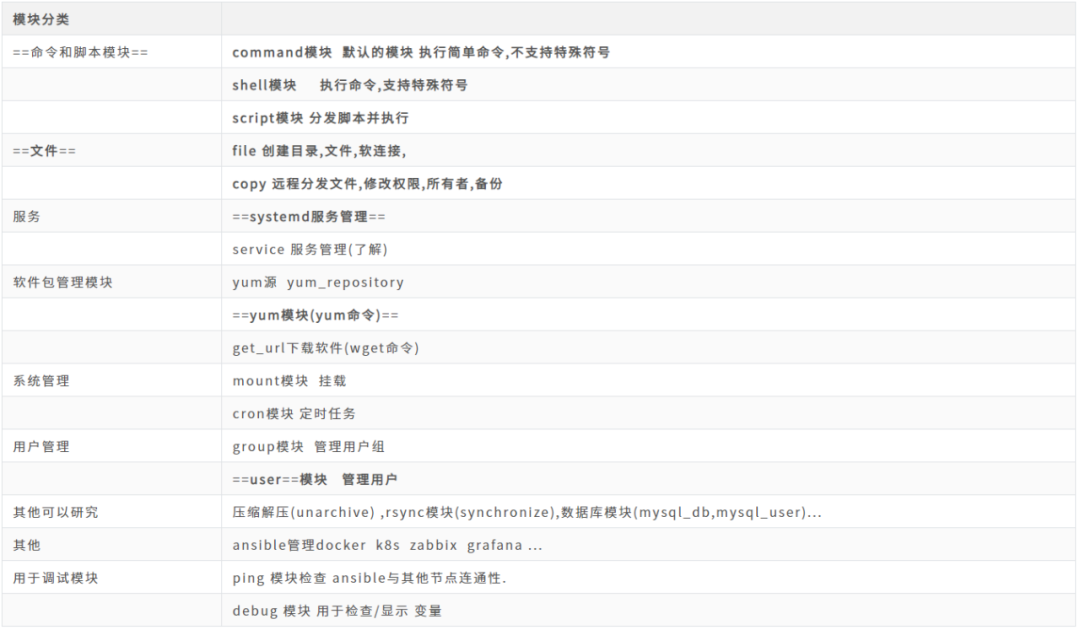
Ansible模块实战-部署rsync服务端 
##rsyncd.conf start## ##rsyncd 20221111 fake super = yes uid = rsync gid = rsync use chroot = no max connections = 200 timeout = 300 pid file = /var/run/rsyncd.pid lock file = /var/run/rsync.lock log file = /var/log/rsyncd.log ignore errors read only = false list = false hosts allow = 172.16.1.0/24 #hosts deny = 0.0.0.0/32 auth users = rsync_backup secrets file = /etc/rsync.password [data] comment = "backup dir by oldboy lidao996" path = /data [backup] comment = "backup dir by oldboy lidao996" path = /backup [nfsbackup] comment = nfsbackup dir by lidao996 path = /nfsbackup 根据命令及对应操作选择ansible模块 
根据选择的模块实现对应的功能 1)服务部署:yum安装或更新 ansible backup -m yum -a name=rsync state=lastest 2)配置文件分发 mkdir -p /server/ans/pro-rsync 准备配置文件存放在 上面目录中 rsyncd.conf ansible backup -m copy -a src=/server/ans/pro-rsync/rsyncd.conf dest=/etc/rsyncd.conf backup=yes 3)虚拟用户 rsync ansible backup -m user -a name=rsync shell=/sbin/nologin create_home=no state=present 4)密码文件和权限 创建文件 ansible backup -m file -a path=/etc/rsync.password mode=600 state=touch 增加 ansible backup -m lineinfile -a path=/etc/rsync.password line="rsync_backup:1" 5)模块对应目录,改所有者 ansible backup -m file -a path=/data owner=rsync group=rsync state=directory 6)重启服务 ansible backup -m systemd -a name=rsyncd enabled=yes state=started 7)命令行测试 [root@m01 /server/ans/pro-rsync]# rsync -av /etc/hostname rsync_backup@172.16.1.31::data 8)指定hosts文件的松提升工位置 [root@m01 /server/ans/pro-rsync]# tree /server/ans/pro-rsync/ /server/ans/pro-rsync/ ├── hosts └── rsyncd.conf 0 directories, 2 files [root@m01 /server/ans/pro-rsync]# ansible -i hosts all -m ping Ansible-playbook(剧本) ansible ad-hoc vs playbook区别 
playbook vs shell脚本 
Playbook剧本极速使用指南 剧本格式叫yaml格式yml 缩进,不要用tab键,率下空格 
核心格式剧本中所有的工作内容要对齐 对齐的时候不能使用tab键 只能使用空格,2个空格 hosts用于指定在哪些主机执行指令 tasks: 用于对于这些主机,运行什么模块及选项 案例01-在所有机器的源码下载/tmp下面创建lidao.txt [root@m01 /server/ans/playbook]# cat 01.touch.yml - hosts: all vars: filename: lidao.txt tasks: - name: touch file shell: touch /tmp/{{ filename}} cp /etc/ansible/hosts . ansible-playbook -i hosts 01.touch.yml [root@m01 /server/ans/playbook]# tree /server/ans/playbook/ /server/ans/playbook/ ├── 01.touch.yml └── hosts 0 directories, 2 files - hosts: all tasks: - name: touch file shell: touch /tmp/lida.txt 案例02-添加定时同步时间的定时任务 原始命令行的ansible命令: ansible all -m cron -a name="sync time by lidao996 20221111" minute="*/2" job="/sbin/ntpdate ntp1.aliyun.com &>/dev/null" state=present ansible -i hosts all -a crontab -l 修改为剧本之后 #简单粗暴版本 --- - hosts: all tasks: - name: add cron sync time cron: name="sync time by lidao996 20221111" minute="*/2" job="/sbin/ntpdate ntp1.aliyun.com &>/dev/null" state=present #格式优化后 --- - hosts: all tasks: - name: add cron sync time cron: name: "sync time by lidao996 20221111" minute: "*/2" job: "/sbin/ntpdate ntp1.aliyun.com &>/dev/null" state: present 在剧本中使用模块和选项,选项最好是一行一个选项,选项后面跟着冒号,选项要对其与缩进。 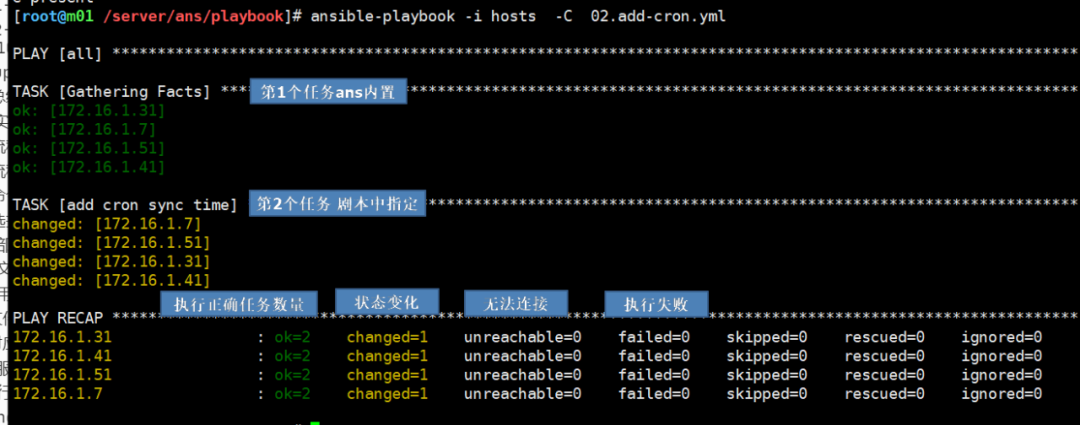
[root@m01 /server/ans/playbook]# ansible -i hosts all -a crontab -l 172.16.1.7 | CHANGED | rc=0 >> #Ansible: sync time by lidao996 20221111 */2 * * * * /sbin/ntpdate ntp1.aliyun.com &>/dev/null 172.16.1.31 | CHANGED | rc=0 >> #Ansible: sync time by lidao996 20221111 */2 * * * * /sbin/ntpdate ntp1.aliyun.com &>/dev/null 172.16.1.41 | CHANGED | rc=0 >> #Ansible: sync time by lidao996 20221111 */2 * * * * /sbin/ntpdate ntp1.aliyun.com &>/dev/null 172.16.1.51 | CHANGED | rc=0 >> #Ansible: sync time by lidao996 20221111 */2 * * * * /sbin/ntpdate ntp1.aliyun.com &>/dev/null 案例03-企业案例-批量下载安装zabbix-agent2-6.0客户端并启动 --- - hosts: all tasks: - name: 1. download zabbix agent2 rpm get_url: ur : https://mirrors.tuna.tsinghua.edu.cn/zabbix/zabbix/6.0/rhel/7/x86_64/zabbix-agent2-6.0.0-1.el7.x86_64.rpm dest: /tmp/ validate_certs: no - name: 2. install zabbix agent2 rpm yu : name: /tmp/zabbix-agent2-6.0.0-1.el7.x86_64.rpm state: installed - name: 3. start zabbix agent2 service s stemd: name: zabbix-agent2 enabled: yes state: started 案例04-部署rsync服务端(剧本) ### 1) 服务部署:yum 安装或更新 ansible backup -m yum -a name=rsync state=lastest ### 2) 配置文件分发 mkdir -p /server/ans/pro-rsync 准备配置文件存放在 上面目录中 rsyncd.conf ansible backup -m copy -a src=/server/ans/pro-rsync/rsyncd.conf dest=/etc/rsyncd.conf backup=yes ### 3) 虚拟用户 rsync ansible backup -m user -a name=rsync shell=/sbin/nologin create_home=no state=present ### 4)密码文件和权限 创建文件 ansible backup -m file -a path=/etc/rsync.password mode=600 state=touch 增加 ansible backup -m lineinfile -a path=/etc/rsync.password line="rsync_backup:1" ### 5)模块对应目录,改所有者 ansible backup -m file -a path=/data owner=rsync group=rsync state=directory ### 6) 重启服务 ansible backup -m systemd -a name=rsyncd enabled=yes state=started [root@m01 /server/ans/playbook]# ansible -i hosts backup -m ping 172.16.1.41 | SUCCESS => { "ansible_facts": { "discovered_interpreter_python": "/usr/bin/python" }, "changed": false, "ping": "pong" } [root@m01 /server/ans/playbook]# cat 05-backup-resyncd.yml --- - hosts: backup tasks: # - name: 1) 服务部署:yum 安装或更新 # yum: # name: rsync # state: latest - name: 2) 配置文件分发 copy: src: /server/ans/playbook/rsyncd.conf dest: /etc/rsyncd.conf backup: yes - name: 3) 虚拟用户 rsync user: name: rsync shell: /sbin/nologin create_home: no state: present - name: 4) 密码文件和权限 lineinfile: path: /etc/rsync.password mode: 0600 line: "rsync_backup:1" create: yes - name: 5) 模块对应目录,改所有者 file: path: /data/ owner: rsync group: rsync state: directory - name: 6) 重启服务 systemd: name: rsyncd enabled: yes state: started 案例05-部署nfs服务端全流程 
Ansible变量系列 
变量详解 1)vars、vars_files、group_vars [root@m01 /server/ans/playbook]# cat 07.vars_dir.yml --- - hosts: all vars: dir_name: /oldboy_lidao file_name: lidao996.icu tasks: - name: 01. mkdir file: path: "{{ dir_name}}" state: directory - name: 02. touch file: path: "{{ dir_name}}/{{ file_name}}" state: touch 把变量存放到一个文件中. 剧本比较大的时候. [root@m01 /server/ans/playbook]# cat 07.vars_dir.yml --- - hosts: all vars: dir_name: /oldboy_lidao file_name: lidao996.icu tasks: - name: 01. mkdir file: path: "{{ dir_name}}" state: directory - name: 02. touch file: path: "{{ dir_name}}/{{ file_name}}" state: touch 创建一个变量文件,给某个组共用 用法:需要创建一个group_vars目录. 目录下面创建以主机组命名的目录. 存放变量文件vars.yml group_vars/ 目录 lb/vars.yml #存放lb组的变量 web/vars.yml #存放web组的变量 data/vars.yml #存放xxx组的变量 all/vars.yml #所有主机共用的变量 案例01-根据不同的主机组创建对应的目录 group_vars/ 目录 web/vars.yml #存放web组的变量 data/vars.yml #存放xxx组的变量 all/vars.yml #所有主机共用的变量 web服务器创建 /app/code/目录 dir_name: /app/code/ data服务端创建 /data/目录 dir_name: /data/ #参考: ##变量文件内容 [root@m01 /server/ans/playbook]# cat group_vars/data/vars.yml dir_name: /datav2/ [root@m01 /server/ans/playbook]# cat group_vars/web/vars.yml dir_name: /app/code/ [root@m01 /server/ans/playbook]# tree group_vars/ group_vars/ ├── data │ └── vars.yml └── web └── vars.yml 3 directories, 3 files #剧本内容 [root@m01 /server/ans/playbook]# cat 09.vars_group_vars_dir.yml - hosts: all tasks: - name: 根据主机创建不同的目录 file: path: "{{ dir_name}}" state: directory 案例02-使用group_vars的all组定义变量 [root@m01 /server/ans/playbook]# tree group_vars/ group_vars/ ├── all │ └── vars.yml ├── data │ └── vars.yml └── web └── vars.yml 3 directories, 3 files [root@m01 /server/ans/playbook]# cat group_vars/all/vars.yml dir_name_code: /app/code/ dir_name_data: /data/ [root@m01 /server/ans/playbook]# cat 09.vars_group_vars_dir.yml - hosts: all tasks: - name: 01 {{ dir_name_code}} file: path: "{{ dir_name_code}}" state: directory - name: 02 {{ dir_name_data}} file: path: "{{ dir_name_data}}" state: directory 剧本目录,目录结构 [root@m01 /server/ans/playbook]# tree . ├── 01.touch.yml ├── 02.add-cron.yml ├── 03.add-cron-you.yml ├── 04.install-zabbix-agent2.yml ├── 05-backup-resyncd.yml ├── 06-nfs-server.yml ├── 07.vars_dir.yml ├── 08.vars_files_dir.yml ├── 09.vars_group_vars_dir.yml ├── group_vars │ ├── all │ │ └── vars.yml │ ├── data │ │ └── vars.yml │ └── web │ └── vars.yml ├── hosts ├── rsyncd.conf └── vars.yml 4 directories, 15 files 变量基础定义小结 
2)ansible-facts变量 facts变量说明== : ansible内置变量,执行剧本,有个默认的任务(task),收集每个主机的基本信息。WordPress模板 #查看 ansible facts变量内容 ansible -i hosts web -m setup 常用fact变量 ansible_hostname #主机名 ansible_memtotal_mb #内存大小(总计) 单位mb ansible_processor_vcpus #cpu数量 ansible_default_ipv4.address #默认的网卡ip eth0 ansible_distribution #系统发行版本名字 CentOS Ubuntu Debian ... ansible_processor_cores #核心总数 ansible_date_time.date #当前时间 年-月-日 案例01-系统巡检-获取所有机器的基础信息保存到/tmp/主机名命名文件中 步骤: 01.创建文件 02.写入内容 [root@m01 /server/ans/playbook]# cat 10.vars_sys_info.yml --- - hosts: all tasks: - name: 创建文件并写入系统基本信息 lineinfile: path: /tmp/{{ ansible_hostname}} create: yes line: "主机名: {{ ansible_hostname}}\n ip地址: {{ ansible_default_ipv4.address}}\n 内存总计: {{ ansible_memtotal_mb}}" - hosts: all gather_facts: no vars: dir_name: /oldboy_lidao file_name: lidao996.icu tasks: - name: 01. mkdir file: path: "{{ dir_name}}" state: directory - name: 02. touch file: path: "{{ dir_name}}/{{ file_name}}" state: touch 3)ansible-register变量 创建压缩包压缩包名字包含时间,tar打包压缩,date获取时间。 tar zcf /tmp/etc-`date +%F`.tar.gz /etc/ 案例01-创建以主机名命名文件/opt/主机名 步骤: 01.获取主机名:hostname 02.创建文件,使用上一步的结果 register: 变量名字 #这个变量的内容,叫json格式. register: hostname #json格式,只想要输出标准输出 stdout standard output 标准输出. hostname.stdout #取出命令的结果 `hostname` [root@m01 /server/ans/playbook]# cat 12.vars_register.yml --- - hosts: all tasks: - name: 01.获取主机名 shell: hostname register: hostname - name: 输出变量内容 debug: msg: "{{ hostname}}" [root@m01 /server/ans/playbook]# cat 12.vars_register.yml --- - hosts: all tasks: - name: 01.获取主机名 shell: hostname register: hostname - name: 输出变量内容 debug: msg: "{{ hostname.stdout}}" - name: 02. 创建文件 file: path: /opt/{{ hostname.stdout}} state: touch register变量输出结果 { "msg": { "changed": true, "cmd": "hostname", "delta": "0:00:00.008150", "end": "2022-04-14 12:32:14.587547", "failed": false, "rc": 0, #命令的返回值,0表示正确,非0错误. "start": "2022-04-14 12:32:14.579397", "stderr": "", #错误信息 "stderr_lines": [], "stdout": "backup02", #这个最常用. 命令的结果,输出. "stdout_lines": [ "backup02" ] } } register: hostname hostname.stdout #正常输出信息 hostname.rc #取出返回值. hostname.stderr #取出错误信息. Ansible-进阶-剧本调试方法 
Debug模块 
案例01-调试-nfs服务端部署剧本 [root@m01 /server/ans/playbook]# cat 13-debug-nfs-server.yml --- - hosts: db tasks: - name: 01. 部署nfs服务端软件 yum: name: nfs-utils state: installed - name: 02. 修改配置文件 lineinfile: path: /etc/exports line: "/data 172.16.1.0/24(rw)" state: present backup: yes - name: 03. 创建对应的目录,权限 file: path: /data/ owner: nfsnobody group: nfsnobody state: directory register: file_jieguo - name: 输出,显示这个过程 debug: msg: "{{ file_jieguo}}" - name: 04. 启动服务-rpc服务 systemd: name: rpcbind enabled: yes state: started - name: 05. 启动服务-nfs服务 systemd: name: nfs enabled: yes state: started tags标签 一般用于调试剧本,给剧本个每个task可以设置个标签 运行剧本的时候可以运行指定标签 运行剧本的时候排除某些标签 [root@m01 /server/ans/playbook]# cat 14-tags-nfs-server.yml --- - hosts: db tasks: - name: 01. 部署nfs服务端软件 yum: name: nfs-utils state: installed tags: - install - name: 02. 修改配置文件 lineinfile: path: /etc/exports line: "/data 172.16.1.0/24(rw)" state: present backup: yes tags: - conf - conf_file - name: 03. 创建对应的目录,权限 file: path: /data/ owner: nfsnobody group: nfsnobody state: directory tags: - conf - conf_dir - name: 04. 启动服务-rpc服务 systemd: name: rpcbind enabled: yes state: started tags: - start_srv - name: 05. 启动服务-nfs服务 systemd: name: nfs enabled: yes state: started tags: - start_srv 运行指定的标签 ansible-playbook -i hosts --tags conf 14-tags-nfs-server.yml ansible-playbook -i hosts --tags conf_file,conf_dir 14-tags-nfs-server.yml 运行剧本的时候排除指定的标签 ansible-playbook -i hosts --skip-tags install,conf_file 14-tags-nfs-server.yml 忽略错误 用于运行剧本的时候,强制让某个任务(模块)运行即使出错了,也不要中断我们的剧本。 [root@m01 /server/ans/playbook]# cat 15-ignore-nfs-server.yml --- - hosts: db tasks: - name: 01. 部署nfs服务端软件 yum: name: nfs-util state: installed ignore_errors: yes tags: - install - name: 02. 修改配置文件 lineinfile: path: /etc/exports line: "/data 172.16.1.0/24(rw)" state: present backup: yes tags: - conf - conf_file - name: 03. 创建对应的目录,权限 file: path: /data/ owner: nfsnobody group: nfsnobody state: directory tags: - conf - conf_dir - name: 04. 启动服务-rpc服务 systemd: name: rpcbind enabled: yes state: started tags: - start_srv - name: 05. 启动服务-nfs服务 systemd: name: nfs enabled: yes state: started tags: - start_srv Ansible-进阶应用 include文件包含:把一个任务分成多个剧本来实现,书写个总剧本文件,通过include_tasks:引用子剧本文件。亿华云 子剧本文件中只需要些模块部分(task部分即可) 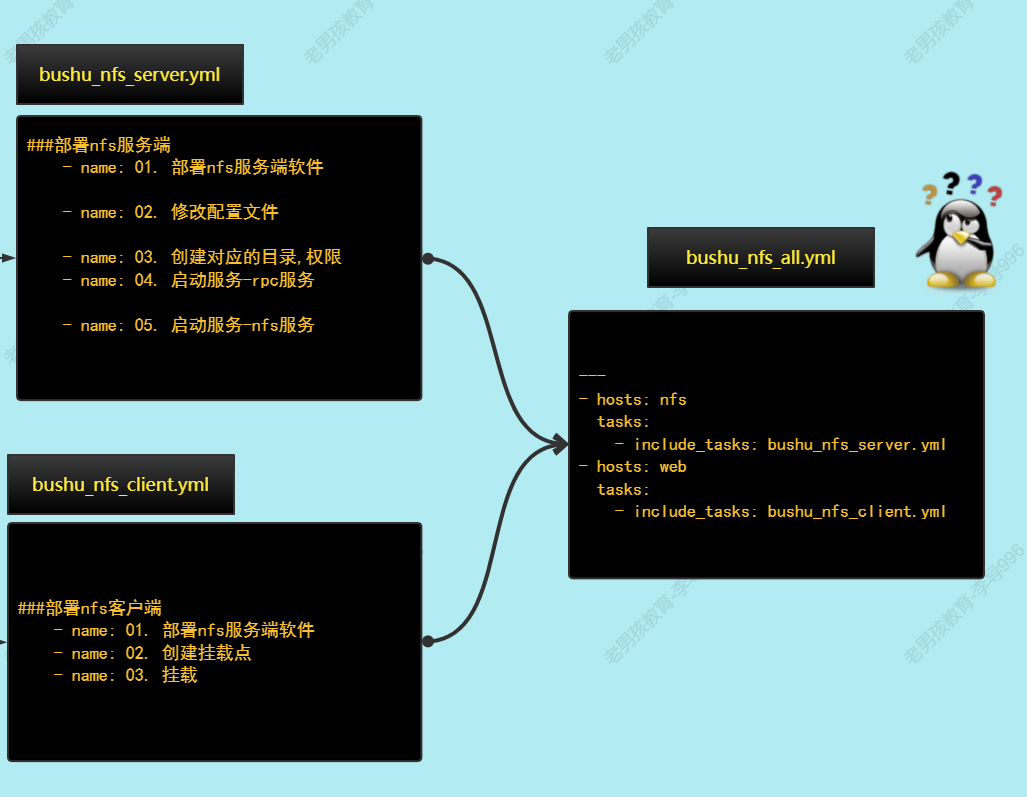
|